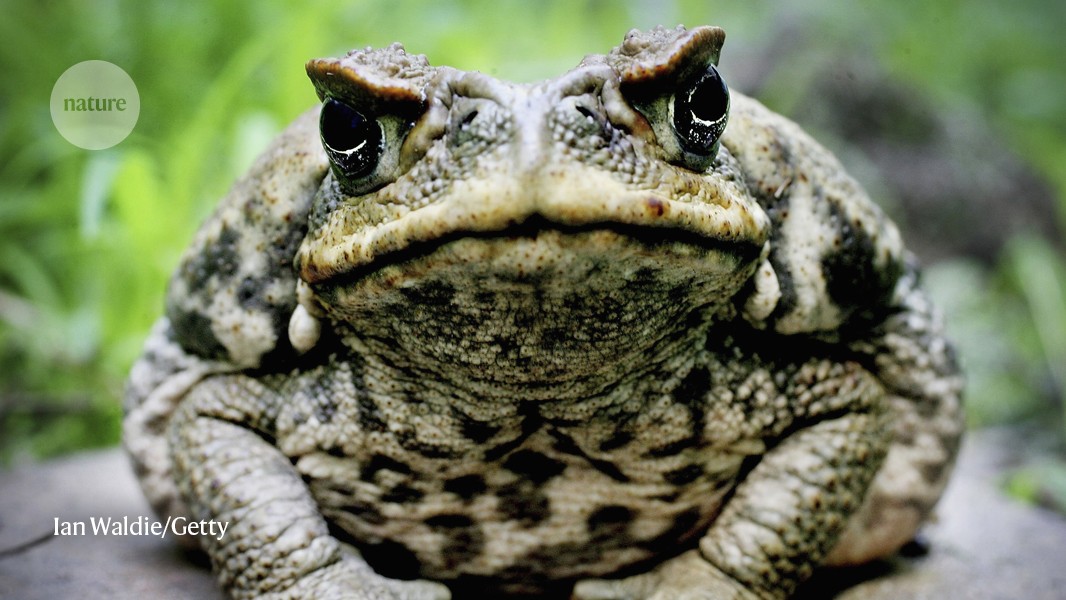
- Select a language for the TTS:
- UK English Female
- UK English Male
- US English Female
- US English Male
- Australian Female
- Australian Male
- Language selected: (auto detect) - EN
Play all audios:
NEWS 25 August 2021 Australia’s cane toads evolved as cannibals with frightening speed Study finds that the noxious pests have become so numerous, they’ve developed a taste for each other —
as well as defences to ward off such attacks. By Max Kozlov Max Kozlov View author publications You can also search for this author in PubMed Google Scholar
Twitter Facebook Email Access through your institution Buy or subscribe The list of ‘deadly animals in Australia’ just got a little weirder. The cane toad, a toxic, invasive species
notorious for devouring anything it can fit in its mouth — household rubbish, small rodents and even birds — has become highly cannibalistic in the 86 years since it was introduced to the
continent, according to a new study. Its counterpart in South America, where cane toads originated, is far less cannibalistic.
Access options Access through your institution Additionalaccess options: Log in Learn about institutional subscriptions Read our FAQs Contact customer support
Nature 597, 19-20 (2021)
doi: https://doi.org/10.1038/d41586-021-02317-9
References DeVore, J. L. et al. Proc. Natl. Acad. Sci. USA 118, e2100765118 (2021).
Article PubMed Google Scholar
DeVore, J. L., Crossland, M. R., and R. Shine. Ecol. Monogr. 91, e01426 (2020).
Article Google Scholar
Download references
Reprints and permissions
Related Articles Ecologists try to speed up evolution to save Australian marsupial from toxic toads
Toad tadpoles turn homegrown poisons on each other
Drones unleashed against invasive rats in the Galapagos
Behind New Zealand’s wild plan to purge all pests
Subjects Evolution Animal behaviour Latest on: Evolution Ancient DNA reveals a two-clanned matrilineal community in Neolithic China
Article 04 JUN 25
Rare ‘ambidextrous’ protein breaks rules of handedness
News 02 JUN 25
Bed bugs boomed as the world’s first cities did
Research Highlight 28 MAY 25
Animal behaviour Clever cockatoos learn an easy way to quench their thirst
Research Highlight 03 JUN 25
Mother–infant bonds in wild chimpanzees resemble those of humans
News & Views 19 MAY 25
Can AI help us talk to dolphins? The race is now on
News 16 MAY 25
Jobs Associate or Senior Editor (Nature Structural & Molecular Biology and Nature Communications) Job Title: Associate or Senior Editor (Nature Structural & Molecular Biology and Nature
Communications) Location: New York, Shanghai, Beijing, Mad...
New York City, New York (US)
Springer Nature Ltd
Postdoctoral Associate – Nima Sharifi Laboratory The Nima Sharifi Laboratory is seeking to recruit outstanding postdoctoral associates with a primary interest in the fundamental mechanisms
of huma...
Miami, Florida (US)
University of Miami Desai Sethi Urology Institute
Associate or Senior Editor, BMC Medicine Job Title: Associate or Senior Editor, BMC Medicine Location(s): Shanghai – Hybrid working model Application Deadline: June 25th, 2025 About
Spri...
Shanghai – Hybrid working model
Springer Nature Ltd
Faculty Recruitment Announcement: Institute for Future Sciences, University of South China We are currently seeking highly qualified candidates for multiple faculty positions across all
academic ranks within the field of biomedical sciences.
Changsha, Hunan, China
University of South China
Principal Investigator Positions at the Institute for Cancer Research, CIMR, Beijing Beijing (CN)
The Chinese Institutes for Medical Research (CIMR), Beijing




